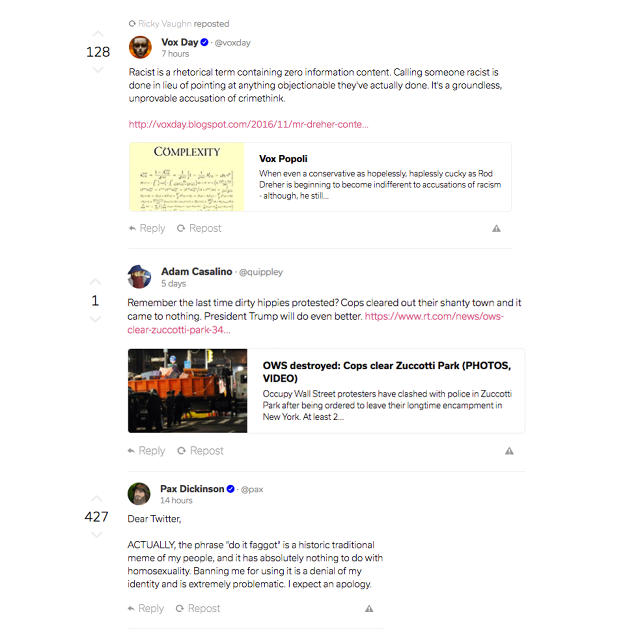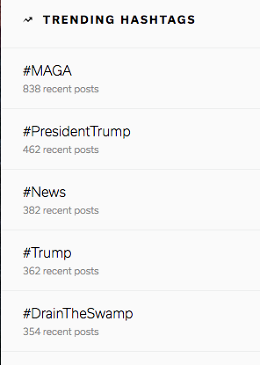The purge is happening. At least according to the universe of alt-right users on social media: Many of them claim that in recent days their Twitter accounts have been suspended and that their posts on Facebook are not being promoted or shared like they used to. It’s all part of a crackdown on “fake news” in the wake of reports that misleading reports shared on Facebook and Twitter helped influence the election. To many, these efforts are an overdue attempt to maintain online civility. But to others it’s blatant censorship.
For those alt-right individuals and other social media refugees who feel that their views are suppressed, there’s a new social network that promises a digital space for completely free and unfettered communications. Gab, a platform that looks and feels like a combination of Twitter and Reddit, is meant to “put people first and promote people first,” as it was described to me by its founder. And this week, it’s been attracting thousands of users, many of them alt-righters exiled from Facebook and Twitter, though its founder insists that it aims to expand beyond that community and build a more diverse audience. Even Richard Spencer, who leads the far-right National Policy Institute think tank and is widely credited with inventing the term “alt-right” had his Twitter account suspended on Tuesday and soon increased the frequency of his posts on Gab.
Gab is the brainchild of Andrew Torba, an adtech startup founder who now lives in Austin after a stint in Silicon Valley. He found the politically progressive atmosphere of the Bay Area to be stifling, making him uncomfortable about expressing his views, and he moved to Texas to help build his fledgling social network. He was once a member of Y Combinator (he was recently ousted), and has now taken on the mission of fixing what he sees as the censorship that plagues online spaces. The tipping point that pushed him to leave the tech bubble and start Gab came earlier this year, when he read that several Facebook employees had come forward to divulge that the network’s trending topics section was actively suppressing conservative news. “I knew I had to take action,” Torba says.
So he created Gab, which is similar to Twitter in that users can only write a limited number of characters (up to 300) in a single post and also mimics Reddit in that these posts can be up-voted or down-voted.
What Is Gab?
Thus far the social network is in closed beta. Torba says it has about 56,000 users along with a waitlist of over 120,000. When Gab first launched in August, it got a little bit of press. But with the election now over there seems to be renewed interest in the platform. Torba tells me that this past Tuesday was the biggest day the site has seen for signups, with more than 5,000 people showing interest in that 24-hour period alone.

This surge in interest very likely has to do with the ongoing debate over fake news and offensive speech on Twitter and Facebook. Earlier this week, Twitter shut down many accounts deemed to be offensive or hateful. And Facebook reportedly has a renegade internal task force working to suppress “fake news,” much of which was conservative content. On Gab, these steps are akin to censorship and are called “The Purge,” and highlights the hypocrisy of supposedly open platforms like Twitter and Facebook.
According to Torba, the real issue with this crackdown is that what constitutes unacceptable conduct is subjective and depends on the eye of the beholder. “Hateful and harassment are subjective terms,” he tells me. In his eyes it shouldn’t be a company’s job to decide what is offensive and what isn’t—especially if the ethos of the organization is to provide an open communicative platform. Gab gives users the ability to mute words they don’t like or accounts they don’t want to see, but the entire point is that it’s user-controlled. (Ironically, Gab’s moderation tools that allow users to mute specific words—sans the ability to block users—are similar to the steps Twitter just implemented to beef up its anti-harassment program.)
Related Video: What Is Facebook Doing to Combat Fake News?
Gab’s logo is a green frog, which looks a hell of a lot like “Pepe,” a meme that became the symbol of the alt-right movement. Torba insists that the logo was inspired by a Biblical passage from Exodus. He sees Gab as “releasing the frogs on the leaders of Big Social and what they’ve been doing… releasing the frogs on Silicon Valley.” He adds that he once saw a YouTube video about an African frog who saved a bunch of tadpoles by digging a pathway to another channel, and this is what he believes he’s doing. Gab’s chief communications officer, Utsav Sanduja, chimes that in ancient Mesopotamia frogs represented “fertility… creation, the birth of new life.”

Can It Expand Beyond Its Core Audience?
Whether or not Gab is able to extend its appeal beyond the alt-right fringe—and become a true competitor to the giants of social media, as Torba told me he wants to do—is difficult to say. Gab, Torba insists, is “not for a specific group.” He goes on to say that he’s been “proactively reaching out to folks in the center,” and following the past week’s success he thinks the audience growth is going to continue to happen. I’ve been scanning the site for a few days and have found nearly every message to consist of support for Trump, condemnation of liberals, or something racist or xenophobic. Torba insists that there’s actually a lot of non-alt-right dialogue going on and that its appeal is global. And in fact, he says, there are many users from Canada, Poland, India, and other countries (he adds that Gab is “going viral” in India right now) but many of them were also sharing conservative views. The Canadian users seem to love Trump as much as the Americans, and many other international users really loved to share conservative memes. Although I did find a small and tight-knit contingent of Indians who discussed local politics.

Torba claims that posts about Trump and conservative views are so dominant on Gab because trending topics is a broken science. “People see what’s trending and they create that content and tag that content,” he says. “That’s why you’re seeing those same trends at the top.” It’s a dynamic problem of how trending works, and doesn’t reflect what the users are actually talking about, says Torba. But most posts I saw were very politically charged and seemed to reflect a very baseline and homogeneous reactionary ethos. Torba admits that the core user base “happens to be right now the folks on the right.” He goes on to say that he hopes people on the left join in and then they too will be heard and free to speak. One way to do that would be to get a major liberal influencer to join in and contribute content. “If we get one major person on the left,” he says, “Rachel Maddow, for example,” then her followers would likely join and perhaps balance out the current narrow stream of ideologies. “That’s our goal,” he says.
Strategizing On How To “Harass The Critics Of Trump”
Call it free speech but some of Gab’s most prominent users are intent on harassment, in their own words. Take one of the most popular Gabbers, Ricky Vaughn. He had a very large following on Twitter with the alt-right community—he’s a proud white nationalist who has publicly called for racial separatism. On Gab, he’s been using a hashtag called #TwitterTerror, which aims to create a culture war on that platform. He calls for Gab users to create anonymous temporary Twitter accounts just to “harass the critics of Trump.” When people like Torba say that harassment is subjective, it’s difficult to couple that with posts that actively call for users to harass.

Though Torba insists that Gab is a place where people considered trolls on Facebook and Twitter can actively discuss their views without fear of suppression, there’s an insidious side to that type of “filter bubble.” It can also serve as a planning ground for these users to start online “warfare” with their online enemies.
Fast Company , Read Full Story
(84)